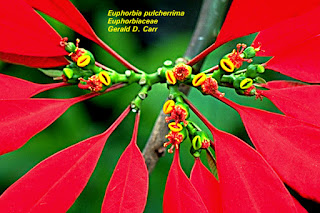Special Type of Inflorescence: Cyathium

Cyathium: Inflorescence Of The Euphorbiaceae Family- One of the largest genera of flowering plants is Euphorbia with approximately 2,000 species. This enormous genus belongs to the very diverse euphorbia family (Euphorbiaceae) with at least 7,500 species. The variation within this genus is astonishing, from low-growing garden weeds called spurges to giant, cactus-like succulents that rival in size our North American sahuaro and organ-pipe cacti. South African euphorbias have evolved succulent, spine-covered stems that greatly resemble North American cacti, a biological phenomenon known as convergent evolution. It is difficult to believe that all these diverse forms belong to the same genus as the showy garden euphorbia called poinsettia ( E. pulcherrima ) until you carefully examine the blossom. The showy, red, modified leaves of poincettia are not petals. In fact, they are not even part of the true flowers. They surround clusters of small, greenish, cup-shaped...









